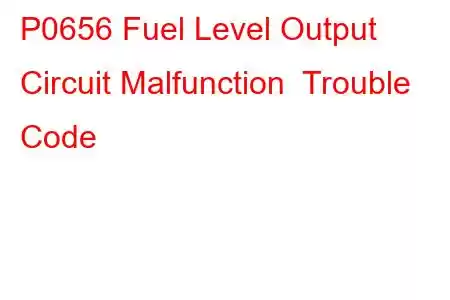P0656 Fuel Level Output Circuit Malfunction
OBD-II Trouble Code Technical Description
Fuel Level Output Circuit Malfunction
What does that mean?
This is a generic diagnostic trouble code (DTC) and applies to many OBD-II vehicles (1996-newer). That may include but is not limited to vehicles from Saturn, Ford, GMC, Mercedes Benz, Holden, etc. Although generic, the exact repair steps may vary depending on year, make, model, and powertrain configuration.
A stored code P0656 means that the powertrain control module (PCM), or one of the other related controllers, has detected a discrepancy in the fuel level output circuit.
The fuel level gauge is an integral part of the instrument panel. With it the driver can monitor the vehicle fuel level when operating the vehicle. Typically, the PCM receives a signal from the fuel level sensor (in the fuel storage tank). This signal allows the PCM to calculate fuel mileage and monitor fuel tank pressure as well as fuel temperature. This data is used to calculate engine fuel delivery strategy and then the fuel level output signal is provided to the fuel gauge and/or instrument panel controller. It may also be output to the low fuel lamp and other on-board controllers.
If a problem is detected in monitoring the fuel level output circuit, a code P0656 will be stored and a malfunction indicator lamp (MIL) may be illuminated.
Typical simple gauges:
What is the severity of this DTC?
A P0656 should be categorized as moderate because it could result in an inoperative fuel gauge and/or drivability issues, and you could potentially run out of gas.
What are some of the symptoms of the code?
Symptoms of a P0656 trouble code may include:
Inoperative fuel level gauge Low fuel lamp is inoperative Low fuel lamp remains illuminated Engine drivability issues Fuel temperature codes Evaporative emission system codesWhat are some of the common causes of the code?
Causes for this code may include:
Open or shorted circuit between the PCM and the instrument panel or other controllers PCM programming error Faulty controller or PCMWhat are some P0656 troubleshooting steps?
Consult your vehicle information source for technical service bulletins (TSB) that replicate the code stored, vehicle (year, make, model, and engine), and symptoms exhibited. If you find the appropriate TSB, it may yield helpful diagnostic information.
A diagnostic scanner and a digital volt/ohmmeter will be necessary to accurately diagnose a code P0656. A reliable source of vehicle information will also be required.
Begin by connecting the scanner to the vehicle diagnostic port and retrieving all stored codes and freeze frame data. You will want to write this information down, just in case the code proves to be an intermittent one.
After recording all pertinent information, clear the codes and test drive the vehicle (if possible) until the code is reset or the PCM enters readiness mode.
If the PCM enters readiness mode, the code is intermittent and will be even more difficult to diagnose. The condition, which caused the P0656 to be stored, may need to worsen before an accurate diagnosis can be reached. On the other hand, if the code fails to reset and there are no drivability symptoms exhibited, the vehicle can be operated normally.
If the P0656 is immediately reset, proceed with a visual inspection of system related wiring and connectors. Harnesses that have been broken of unplugged should be repaired or replaced as required.
If wiring and connectors appear functional, use your source of vehicle information to obtain the appropriate wiring diagrams, connector face views, connector pin-out charts, and diagnostic flow charts.
Once you have the correct information, use your DVOM to test the fuel level output circuit at the appropriate pin of the PCM conn
Read: 38


